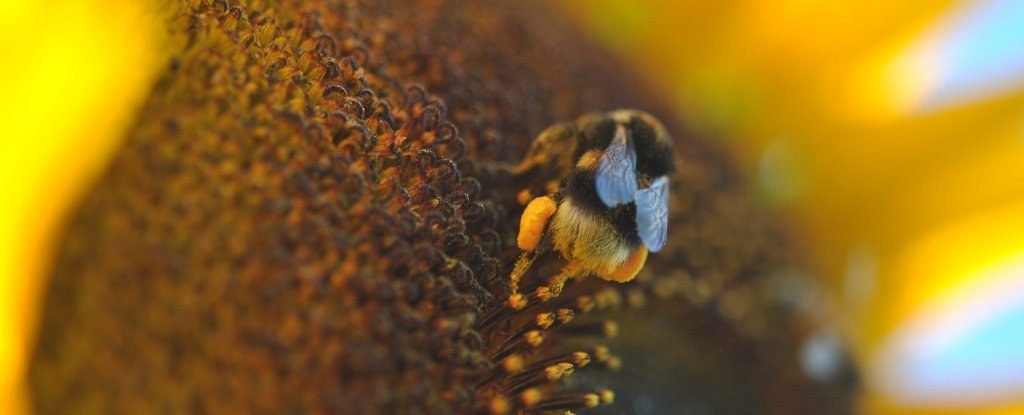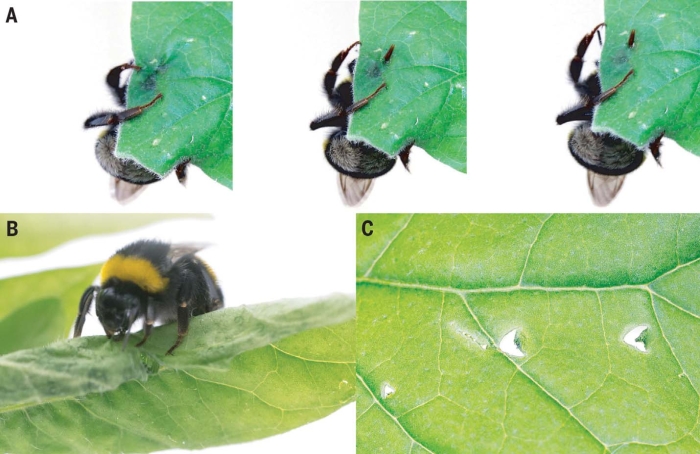
Bumblebees Bite Plants to Make Them Bloom, Scientists Find
by MICHELLE STARRWhen you wake up hungry and there's nothing to eat, the most sensible thing to do is acquire snacks. In this, bumblebees are no different from humans. If they wake early from hibernation to find a scarcity of pollen, the insects have a cunning way to force plants to flower.
Using their mandibles and proboscises, bumblebees (Bombus terrestris) chew holes in plant leaves, causing them to bloom weeks earlier than they usually would, in turn supplying the bees with food.
It could be providing the fuzzy little insects with a valuable survival tool when warmer temperatures due to climate change wake them from hibernation early - that is, before plants usually start flowering.
Researchers at ETH Zürich first noticed the peculiar behaviour in a greenhouse they had set up to study how bees respond to plant smells, Science Magazine reported.
"Initial behavioural observations with four plant species revealed that bumblebee workers use their proboscises and mandibles to cut distinctively shaped holes in plant leaves, with each damage event taking only a few seconds," the researchers wrote in their paper.
"However, we saw no clear evidence that bees were actively feeding on leaves or transporting leaf material back to the hive."
Previous research had found that abiotically inducing stress in plants could accelerate the flowering timeline. So, the researchers hypothesised that if the bees were not eating the leaves or using them for nests, perhaps the plant-munching was for another reason - using this plant stress response to get aboard the pollen train sooner.
To test this idea, the team put mesh cages over black mustard (Brassica nigra) and tomato plants (Solanum lycopersicum) that weren't due to flower, and released hungry, pollen-deprived bumblebees inside.
As a control, more plants of each kind were set up in a greenhouse without bumblebees; in another group of each plant, the researchers themselves cut holes in the leaves in the same-half-moon shapes they'd seen the bumblebees cut. Then, they watched and waited.

The results were jaw-dropping. Black mustard plants chewed by bumblebees flowered on average 16 days earlier than the unchewed controls. The tomato plants were even more striking - they flowered up to 30 days earlier.
The team also found that bumblebees deprived of pollen conducted significantly more damage to non-flowering plants than the bees with sufficient food, suggesting that hunger drives the rate at which bumblebees damage plants.
They even saw two other species of bumblebee - the red-tailed bumblebee (B. lapidarius) and white-tailed bumblebee (B. lucorum) damaging plants in the same manner, confirming that the behaviour is not exclusive to commercial bumblebee hives.
Where it gets really interesting though, is when it comes to the plants the researchers cut up to mimic bumblebee damage. They flowered earlier than the undamaged controls, but not nearly as early as the plants chewed by bees. The human-damaged mustard plants only flowered eight days earlier, and the tomato plants just five.
Why this is the case is not yet known. It's possible that the bees release a chemical that triggers a stronger response in the plants, but more research will be needed to figure this out for sure.
The results do suggest that bumblebees have access to an adaptive survival tool that could prove vital as the climate continues to warm. It's possible that the plants have adapted to respond to this bee-haviour, too - if the bumblebees die from lack of food, pollination could be greatly reduced, so it benefits the plants to flower when their pollinators need them to.
In turn, this could mean these organisms are just a little bit more resistant to a changing climate than we thought, which is encouraging in the face of the growing climate crisis.
"The demonstration that bee-inflicted leaf damage can have strong effects on time to flowering may have important ecological implications, including for the resilience of plant-pollinator interactions to increases in phenological asymmetry caused by anthropogenic environmental changes," the researchers wrote.
The research has been published in Science.